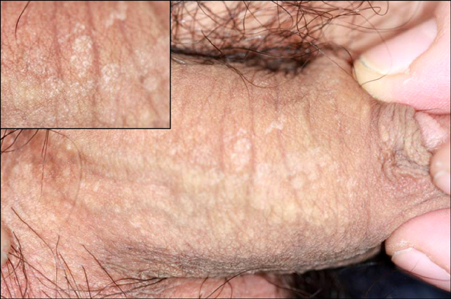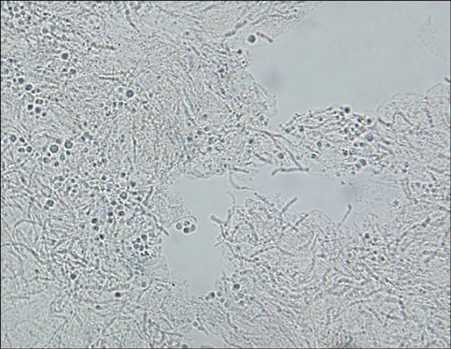Ann Dermatol.
2012 Aug;24(3):345-347. 10.5021/ad.2012.24.3.345.
Pityriasis Versicolor on Penile Shaft in a Renal Transplant Recipient
- Affiliations
-
- 1Department of Dermatology, Keimyung University School of Medicine, Daegu, Korea. kmderma@dsmc.or.kr
- KMID: 2265309
- DOI: http://doi.org/10.5021/ad.2012.24.3.345
Abstract
- Pityriasis versicolor is a superficial infection of the stratum corneum, which is caused by the Malassezia species. Tge Malassezia species consist of 12 subspecies, including M. furfur, M. pachydermatis, M. symphodialis and M. globasa. The Malassezia species are classified as a normal flora, particularly in the sebum rich areas of the skin, and they convert from saprophytic yeast to parasitic mycelial morpholgic form to cause clinical disease. But majorities of their distributions are in the upper back, the neck, the thighs, and the forearm, and not in the penis. It is well known that the renal transplant patients, who take immunosuppressive agents, have impairment in the protective cell mediated immunity. Thus, they are more susceptible to infectious diseases, such as a fungal infection. Therefore, clinical manifestations show higher incidence of disease, but they mostly occur in an expected distribution. We here report a case of pityriasis versicolor in a renal transplant recipient on penile shaft, which is an unusual area.
Keyword
MeSH Terms
Figure
Reference
-
1. Wolff K, Goldsmith LA, Katz SI, Gilchrest BA, Paller AS, Leffell DJ. Fitzpatrick's dermatology in general medicine. 2008. 7th ed. New York: McGraw-Hill;1822–1830.2. Saadatzadeh MR, Ashbee HR, Cunliffe WJ, Ingham E. Cell-mediated immunity to the mycelial phase of Malassezia spp. in patients with pityriasis versicolor and controls. Br J Dermatol. 2001. 144:77–84.
Article3. Smith EL. Pityriasis versicolor of the penis. Br J Vener Dis. 1978. 54:441.
Article4. Blumenthal HL. Tinea versicolor of penis. Arch Dermatol. 1971. 103:461–462.
Article5. Nia AK, Smith EL. Pityriasis versicolor of the glans penis. Br J Vener Dis. 1979. 55:230.
Article6. Khaddar RK, Cherif F, Ben Hadid R, Mokni M, Ben Osman A. Penile shaft involvement in pityriasis versicolor. Acta Dermatovenerol Alp Panonica Adriat. 2008. 17:86–89.7. Güleç AT, Demirbilek M, Seçkin D, Can F, Saray Y, Sarifakioglu E, et al. Superficial fungal infections in 102 renal transplant recipients: a case-control study. J Am Acad Dermatol. 2003. 49:187–192.
Article8. Shuttleworth D, Philpot CM, Salaman JR. Cutaneous fungal infection following renal transplantation: a case control study. Br J Dermatol. 1987. 117:585–590.
Article9. Aridoğan IA, Ilkit M, Izol V, Ates A. Malassezia and Candida colonisation on glans penis of circumcised men. Mycoses. 2005. 48:352–356.
Article10. Ashbee HR. Update on the genus Malassezia. Med Mycol. 2007. 45:287–303.11. Boardman CR, Malkinson FD. Tinea versicolor in steroid-treated patients. Incidence in patients with chronic ulcerative colitis and regional enteritis treated with corticotropin and corticosteroids. Arch Dermatol. 1962. 85:44–52.12. Sugita T, Tajima M, Ito T, Saito M, Tsuboi R, Nishikawa A. Antifungal activities of tacrolimus and azole agents against the eleven currently accepted Malassezia species. J Clin Microbiol. 2005. 43:2824–2829.
Article13. Meier-Kriesche HU, Friedman G, Jacobs M, Mulgaonkar S, Vaghela M, Kaplan B. Infectious complications in geriatric renal transplant patients: comparison of two immunosuppressive protocols. Transplantation. 1999. 68:1496–1502.
Article
- Full Text Links
- Actions
-
Cited
- CITED
-
- Close
- Share
- Similar articles
-
- Clinical Efficacy and Tolerability of Terbinafine 1% Cream in Patients with Pityriasis Versicolor
- Pityriasis Versicolor Atrophicans
- Two Cases of Pityriasis Versicolor on the Scalp in the Course of Treatment for Alopecia Totalis
- Malassezia Species Cultured from the Lesions of Pityriasis Versicolor
- Atrophying Pityriasis Versicolor: Is This a New Variant of Pityriasis Versicolor?



